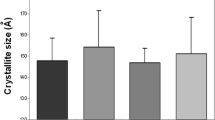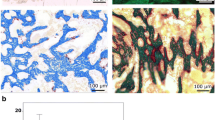Abstract
Strontium ranelate (SrR) is a new agent used in the treatment of osteoporosis and is suggested to reduce bone resorption and increase bone formation. We investigated whether SrR influences the macro- and nanomechnical properties of healing fractures in rats. A closed tibia fracture model was used to study fracture healing in rats after 3 and 8 weeks of healing. Two groups of rats were treated with SrR (900 mg/kg/day) mixed into the food, while two groups served as control animals. The healing fractures were investigated by three-point bending, dual energy X-ray absorptiometry, energy-dispersive X-ray spectroscopy (EDX), and nanoindentation. There was a 100-fold increase (P < 0.001) in serum Sr after 3 and 8 weeks of SrR treatment. The callus volume was significantly higher in the SrR-treated group than in control animals (P < 0.01) after 3 weeks of healing. This was accompanied by a significant increase in callus bone mineral content (P < 0.05). However, after 8 weeks of healing, no difference was found in either callus volume or bone mineral content. SrR did not influence maximum load or stiffness of the fractures after either 3 or 8 weeks of healing. EDX showed that Sr was incorporated into the callus; however, this did not influence the nanomechanical properties. In conclusion, SrR stimulates callus formation but has no effect on callus remodeling. Sr is incorporated into the newly formed callus tissue, but this has no deteriorating effect on the mechanical properties of rat tibial fractures at either the macroscopic or nanoscopic level after 3 or 8 weeks of healing.






Similar content being viewed by others
References
Meunier PJ, Roux C, Seeman E, Ortolani S, Badurski JE, Spector TD, Cannata J, Balogh A, Lemmel EM, Pors-Nielsen S, Rizzoli R, Genant HK, Reginster JY (2004) The effects of strontium ranelate on the risk of vertebral fracture in women with postmenopausal osteoporosis. N Engl J Med 350:459–468
Reginster JY, Felsenberg D, Boonen S, Diez-Perez A, Rizzoli R, Brandi ML, Spector TD, Brixen K, Goemaere S, Cormier C, Balogh A, Delmas PD, Meunier PJ (2008) Effects of long-term strontium ranelate treatment on the risk of nonvertebral and vertebral fractures in postmenopausal osteoporosis: results of a five-year, randomized, placebo-controlled trial. Arthritis Rheum 58:1687–1695
Reginster JY, Seeman E, De Vernejoul MC, Adami S, Compston J, Phenekos C, Devogelaer JP, Curiel MD, Sawicki A, Goemaere S, Sorensen OH, Felsenberg D, Meunier PJ (2005) Strontium ranelate reduces the risk of nonvertebral fractures in postmenopausal women with osteoporosis: Treatment of Peripheral Osteoporosis (TROPOS) study. J Clin Endocrinol Metab 90:2816–2822
Ammann P, Shen V, Robin B, Mauras Y, Bonjour JP, Rizzoli R (2004) Strontium ranelate improves bone resistance by increasing bone mass and improving architecture in intact female rats. J Bone Miner Res 19:2012–2020
Delannoy P, Bazot D, Marie PJ (2002) Long-term treatment with strontium ranelate increases vertebral bone mass without deleterious effect in mice. Metabolism 51:906–911
Marie PJ, Hott M, Modrowski D, De Pollak C, Guillemain J, Deloffre P, Tsouderos Y (1993) An uncoupling agent containing strontium prevents bone loss by depressing bone resorption and maintaining bone formation in estrogen-deficient rats. J Bone Miner Res 8:607–615
Fuchs RK, Allen MR, Condon KW, Reinwald S, Miller LM, McClenathan D, Keck B, Phipps RJ, Burr DB (2008) Strontium ranelate does not stimulate bone formation in ovariectomized rats. Osteoporos Int 19:1331–1341
Geoffroy V, Chappard D, Marty C, Libouban H, Ostertag A, Lalande A, De Vernejoul MC (2010) Strontium ranelate decreases the incidence of new caudal vertebral fractures in a growing mouse model with spontaneous fractures by improving bone microarchitecture. Osteoporos Int 25:968–975
Hott M, Deloffre P, Tsouderos Y, Marie PJ (2003) S12911-2 reduces bone loss induced by short-term immobilization in rats. Bone 33:115–123
Marie PJ (2006) Strontium ranelate: a physiological approach for optimizing bone formation and resorption. Bone 38:S10–S14
Bonnelye E, Chabadel A, Saltel F, Jurdic P (2008) Dual effect of strontium ranelate: stimulation of osteoblast differentiation and inhibition of osteoclast formation and resorption in vitro. Bone 42:129–138
Brennan TC, Rybchyn MS, Green W, Atwa S, Conigrave AD, Mason RS (2009) Osteoblasts play key roles in the mechanisms of action of strontium ranelate. Br J Pharmacol 157:1291–1300
Atkins GJ, Welldon KJ, Halbout P, Findlay DM (2009) Strontium ranelate treatment of human primary osteoblasts promotes an osteocyte-like phenotype while eliciting an osteoprotegerin response. Osteoporos Int 20:653–664
Hurtel-Lemaire AS, Mentaverri R, Caudrillier A, Cournarie F, Wattel A, Kamel S, Terwilliger EF, Brown EM, Brazier M (2009) The calcium-sensing receptor is involved in strontium ranelate-induced osteoclast apoptosis. New insights into the associated signaling pathways. J Biol Chem 284:575–584
Fromigue O, Hay E, Barbara A, Petrel C, Traiffort E, Ruat M, Marie PJ (2009) Calcium sensing receptor-dependent and receptor-independent activation of osteoblast replication and survival by strontium ranelate. J Cell Mol Med 13:2189–2199
Cebesoy O, Tutar E, Kose KC, Baltaci Y, Bagci C (2007) Effect of strontium ranelate on fracture healing in rat tibia. Joint Bone Spine 74:590–593
Habermann B, Kafchitsas K, Olender G, Augat P, Kurth A (2010) Strontium ranelate enhances callus strength more than PTH 1-34 in an osteoporotic rat model of fracture healing. Calcif Tissue Int 86:82–89
Li YF, Luo E, Feng G, Zhu SS, Li JH, Hu J (2010) Systemic treatment with strontium ranelate promotes tibial fracture healing in ovariectomized rats. Osteoporos Int 21:1889–1897
Ozturan KE, Demir B, Yucel I, Cakıcı H, Yilmaz F, Haberal A (2011) Effect of strontium ranelate on fracture healing in the osteoporotic rats. J Orthop Res 29(1):138–142
Phillips AM (2005) Overview of the fracture healing cascade. Injury 36:5–7
Einhorn TA (2005) The science of fracture healing. J Orthop Trauma 19:S4–S6
Boivin G, Meunier PJ (2003) The mineralization of bone tissue: a forgotten dimension in osteoporosis research. Osteoporos Int 14(suppl 3):S19–S24
Ulrich-Vinther M, Schwarz EM, Pedersen FS, Soballe K, Andreassen TT (2005) Gene therapy with human osteoprotegerin decreases callus remodeling with limited effects on biomechanical properties. Bone 37:751–758
Andreassen TT, Ejersted C, Oxlund H (1999) Intermittent parathyroid hormone (1-34) treatment increases callus formation and mechanical strength of healing rat fractures. J Bone Miner Res 14:960–968
Institute of Laboratory Animal Research, Commission on Life Sciences National Research Council (1996) Care and use of laboratory animals. National Academic Press, Washington, DC
Turner CH, Burr DB (1993) Basic biomechanical measurements of bone—a tutorial. Bone 14:595–608
Andreassen TT, Jorgensen PH, Flyvbjerg A, Orskov H, Oxlund H (1995) Growth hormone stimulates bone formation and strength of cortical bone in aged rats. J Bone Miner Res 10:1057–1067
Oliver WC, Pharr GM (1992) An improved technique for determining hardness and elastic-modulus using load and displacement sensing indentation experiments. J Mater Res 7:1564–1583
Kenedi RM (1980) Human body biomechanics. In: Kenedi RM (ed) A textbook of biomedical engineering. Blackie & Son, Glasgow, pp 1–73
Mosekilde L, Bak B (1993) The effects of growth-hormone on fracture-healing in rats—a histological description. Bone 14:19–27
Jee WS, Yao W (2001) Overview: animal models of osteopenia and osteoporosis. J Musculoskelet Neuronal Interact 1:193–207
Namkung-Matthai H, Appleyard R, Jansen J, Hao LJ, Maastricht S, Swain M, Mason RS, Murrell GA, Diwan AD, Diamond T (2001) Osteoporosis influences the early period of fracture healing in a rat osteoporotic model. Bone 28:80–86
Kim HW, Jahng JS (1999) Effect of intermittent administration of parathyroid hormone on fracture healing in ovariectomized rats. Iowa Orthop J 19:71–77
McCann RM, Colleary G, Geddis C, Clarke SA, Jordan GR, Dickson GR, Marsh D (2008) Effect of osteoporosis on bone mineral density and fracture repair in a rat femoral fracture model. J Orthop Res 26:384–393
Li C, Paris O, Siegel S, Roschger P, Paschalis E, Klaushofer K, Fratzl P (2010) Strontium is incorporated into mineral crystals only in newly formed bone during strontium ranelate treatment. J Bone Miner Res 25:968–975
Bünger MH, Oxlund H, Hansen TK, Sorensen S, Bibby BM, Thomsen JS, Langdahl BL, Besenbacher F, Pedersen JS, Birkedal H (2010) Strontium and bone nanostructure in normal and ovariectomized rats investigated by scanning small-angle X-ray scattering. Calcif Tissue Int 86:294–306
Roschger P, Manjubala I, Zoeger N, Meirer F, Simon R, Li C, Fratzl-Zelman N, Misof BM, Paschalis EP, Streli C, Fratzl P, Klaushofer K (2010) Bone material quality in transiliac bone biopsies of postmenopausal osteoporotic women after 3 years of strontium ranelate treatment. J Bone Miner Res 25:891–900
Blake GM, Lewiecki EM, Kendler DL, Fogelman I (2007) A review of strontium ranelate and its effect on DXA scans. J Clin Densitom 10:113–119
Nielsen SP, Slosman D, Sorensen OH, Basse-Cathalinat B, De CP, Roux CR, Meunier PJ (1999) Influence of strontium on bone mineral density and bone mineral content measurements by dual X-ray absorptiometry. J Clin Densitom 2:371–379
Acknowledgments
This investigation was supported by Lægevidenskabens Fremme Foundation, the Aarhus University Research Foundation, and the Danish Council for Independent Research, Natural Sciences. The financial support of Director Ib Henriksen’s Foundation and of the Idella Foundation for establishing the ICP-MS apparatus with APEX nebulizer are gratefully acknowledged. The authors thank Jytte Utoft for technical assistance.
Disclosures
None.
Author information
Authors and Affiliations
Corresponding author
Additional information
The authors have stated that they have no conflict of interest.
Rights and permissions
About this article
Cite this article
Brüel, A., Olsen, J., Birkedal, H. et al. Strontium Is Incorporated into the Fracture Callus but Does Not Influence the Mechanical Strength of Healing Rat Fractures. Calcif Tissue Int 88, 142–152 (2011). https://doi.org/10.1007/s00223-010-9439-z
Received:
Accepted:
Published:
Issue Date:
DOI: https://doi.org/10.1007/s00223-010-9439-z




